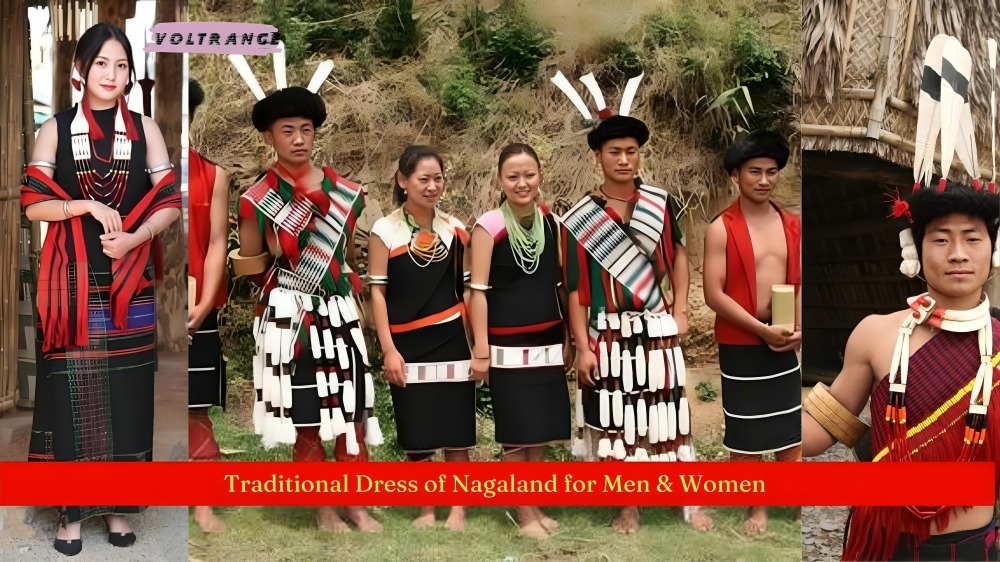
Traditional Dress of Nagaland for Men & Women
Traditional and Cultural Dress of Nagaland: Nagaland, known for its rich cultural heritage, has gained increasing popularity over the years, attracting visitors from all corners of the world. Whether you’re a nature enthusiast or a thrill seeker, Nagaland offers something unique for everyone. One of the standout features of its vibrant culture is its traditional attire, which showcases both elegance and heritage. From beautifully crafted skirts to striking warrior shawls, Nagaland’s clothing is as diverse as it is enchanting. Here’s a glimpse into the traditional dresses worn by the men and women of Nagaland that are sure to captivate visitors.
Traditional Dresses of Nagaland for Women
Neikhro
The Neikhro is a traditional skirt worn by the Angami women, draped elegantly around the waist. This beautiful garment resembles the traditional dress of Manipuri women, and its intricate design and elegant pattern make it an eye-catching piece. Its charm lies in its simplicity and timeless appeal. Traditional Dress of Nagaland
Azu Jangup Su
Azu Jangup Su is a festive attire typically worn during special celebrations. This long, straight-cut black skirt is decorated with bold yellow and red striped boxes. Paired with a matching blouse or top, and accessorized with bangles, necklaces, and traditional headgear, the Azu Jangup Su creates a stunning festive look.
Mechala
The Mechala is a striking combination of a skirt and shawl, making it an essential part of Nagame women’s traditional dress. This attire represents not just beauty, but also the culture of the region. With its blend of comfort, style, and color, the Mechala showcases the unique identity of Nagaland’s women. Traditional Dress of Nagaland
Moyer Tusk
Featuring a bold zigzag pattern, the Moyer Tusk dress is known for its elegance. Traditionally dyed in deep blue, this garment has evolved over the centuries but retains its distinctive charm. The zigzag design along the edges adds a touch of sophistication, and when paired with jewelry, this attire exudes grace.
Lohe
Lohe is an Angami tribal dress characterized by red and yellow bands that circle the garment. Worn by the Angami tribes residing in western Nagaland, the Lohe is more than just attire—it’s a symbol of tradition and cultural heritage. The unique patterns found in this dress reflect the distinctiveness of the tribe. Traditional Dress of Nagaland
Traditional Dresses of Nagaland for Men
Tsungkotepsu
The Tsungkotepsu is a warrior’s shawl worn by the Ao tribe. Adorned with various animal motifs such as Mithun (a symbol of wealth), cocks, human heads (denoting success), tigers, and elephants (representing hunting prowess), this shawl tells the story of the wearer’s achievements. The designs, usually in black, are printed on a white band, making this shawl both a cultural and artistic statement.
Alungstu and Lungpensu
Alungstu is a traditional outfit that signifies success and prosperity, often worn by influential families. Typically dyed in yellow or red, it features floral motifs symbolizing good fortune. Lungpensu, on the other hand, is a dark blue garment with a narrow striped border. Its central checkered design in white and red is highlighted by five light blue stripes, making it a distinctive piece of clothing. Traditional Dress of Nagaland
Ratapfe and Khiamniungan Attire
Ratapfe is a simple, everyday black shawl embedded with cowrie shells in its third and fourth rows. Khiamniungan attire, worn by the Khiamniungan tribe, consists of a sleeveless cotton suit, usually in blue or black. Both outfits are traditional yet practical, blending comfort with cultural expression.
Rhikho
The Rhikho is a traditional white cloth with four black bands. It is worn by men who haven’t participated in hunting or hosted a large feast for their community. This simple yet symbolic dress reflects Nagaland’s cultural values of achievement and community service. Traditional Dress of Nagaland
Changs (Shawls)
Chang shawls come in a variety of styles, each with its own significance. Tobu nei has a geometric pattern with red and black lines, while Kaksi nei is a versatile garment worn by both men and women. Rongkhim, a red triangular shawl, is reserved for those who have taken lives in war. Other shawls, such as Yimchunger, Mokhok, and Aneak Khim, are also significant in the traditional dress of Nagaland’s men.
Conclusion
Nagaland’s traditional attire is a celebration of its rich cultural diversity and history. Each piece, from the vibrant Azu Jangup Su to the warrior-like Tsungkotepsu, carries its own story of bravery, wealth, joy, and tradition. Whether it’s the intricate patterns on women’s skirts or the symbolic shawls worn by men, Nagaland’s clothing offers a unique glimpse into the state’s cultural fabric—one that continues to captivate and inspire all who visit. Traditional Dress of Nagaland





More Stories
which of the following statements is true about education and lifetime earnings? Complete Guide Here
Statekaidz.com: Education with Fun For Kids 2025
Top 5 Richest States in India by GDP